#S-Bahn Dresden
Text
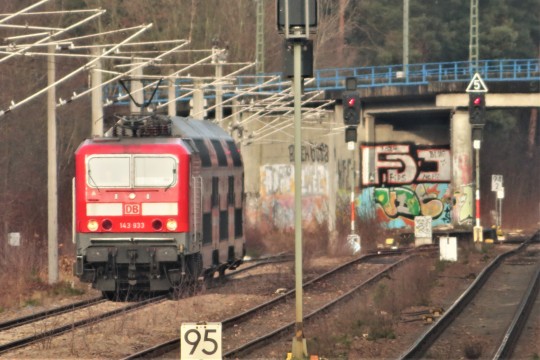
143 933 in Dresden Klotzsche am 09.02.2024
#143 933#Br143#Br 143#S-Bahn Dresden#S-Bahn#Dresden#Dresden-Klotzsche#Klotzsche#Dresden Klotzsche#Eisenbahn#Bahnhof#Bahn#Flughafen Dresden#Dosto
2 notes
·
View notes
Text
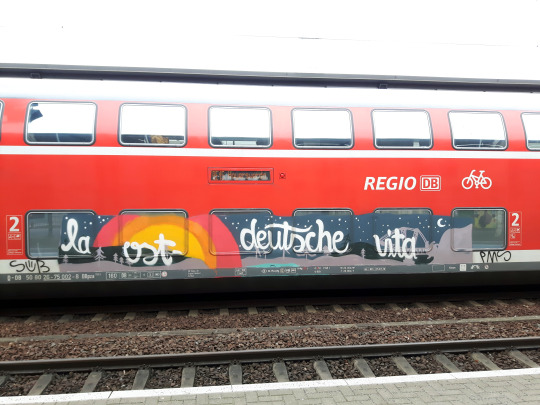

Day&Night
#Samsung Galaxy S5 neo#Handyuploads#la ost deutsche vita#pms#grafitti#Dresden#Mitte#DB Regio Südost#S-Bahn#S Bahn#süß#RE15
2 notes
·
View notes
Text
Immer häufiger spüren die Menschen in Sachsen die Folgen mangelnder Zuwanderung. Dennoch halten AfD und CDU im Land ihre Gegenwehr aufrecht. Die FDP würde es ebenfalls machen, wenn sie irgendwas zu sagen hätte.
Dabei wird der Landeshaushalt von Sachsen ohnehin zu 2/3 aus EU-Mitteln, Zuwendungen des Bundes und dem Länderfinanzausgleich bestritten.
2 notes
·
View notes
Text
#aFactADay2021
#352: the Dresden transport system is epic. they have two massive intercity stations (Dresden Hauptbahnhof and Dresden-Neustadt), a 48-station S-Bahn, a whopping 10-line Tramway with over 200km and the longest trams in the world, and buses that have their own kerb named after them: the Dresdner Combibord kerb is a raised kerb with a curved side like so so that buses can easily line themselves up but it also interfaces smoothly with the low-floor trams. its essentially a special version of the Kassel curb that also allows for accessibility to trams.
the best part about the dresden trams - apart from the fact they look epic - is wikipedia says their propulsion system is horse
0 notes
Link
#dovetailgames#games#playstation#simulation#train#trainoperation#trainsimworld#trainsimworld4#unrealengine#videogame#windowspc#xbox
0 notes
Text
Saturday 4 July 1998 - the S-Bahn ring train and one week from the Love Parade in Berlin
Saturday 4th July 1998
Hi everyone
Hope you had a happy 4th of July. Even if I am overseas on the 4th of July, I try to make the day meaningful. Summer 1998 was no exception, nor was Summer 1997 when I visited Zurich and Milan that weekend. The morning of 4th July 1998 was on Saturday, so I had to do some grocery shopping. I also bought some music CDs at the Media Markt near the V-Markt in the EuroIndustriepark, to listen to. Here is what I bought.
"Metamorphosis" from Culture Beat
"Flowers" from Ace of Base
Single "Bailando" from Loona (Bailando, bailando amigos adios, adios, el silencio loco)
Why did I not buy
"Bleibt alles anderes" from Herbert Grönemeyer
"13" from Die Ärzte (with "Männer sind Schweine")
"Read my sign" from Bell Book & Candle (with "Rescue Me", the official video has surreal efffects)
I am not sure, but in the last few months I did buy "Bleibt alles anderes"
There was still time to buy other music as the month progressed. After I brought the groceries and music CDs home, it was time to head to München Hbf, for a special train. The fare was 4.50 D-Mark My usual month pass would not be valid, so I would have to buy a ticket from the conductors. This included a day pass on the train and a free sandwich on a pretzel bun and 12 ounce / 330 mL can of soft drink.
Why was the train ride special? It was not a regularly scheduled route. It was organized by people who I think were lobbyists for an S-Bahn ring around Munich, instead of a monorail. The train was built of four second class compartment cars @6 people per compartment and one single-aisle seating car, and driven by a DB-218 diesel locomotive. The route was clockwise and started out of München Hbf, went as far north as Moosach, then went through the EuroIndustriepark without stopping, turned south at Johanneskirchen, stopping for a few minutes at Ostbahnhof, before continuing on to Moosach. The lobbyists gave an objective speech over the loudspeaker *auf Deutsch* on the existing infrastructure, and why they would lobby for an S-Bahn ring. I must have stayed on the train for two more rotations to Ostbahnhof, I think a further hour and a half. The turnout on the train was quite good. I made it back to Hauptbahnhof to see what I could do to get a seat on the Sommer-Spezial IC train from Berlin Zoo to München Hbf via Leipzig and Nürnberg.
This one is quite difficult to explain, given its complexities, so please bear with me. As for arranging a train ride from Munich to Berlin on the Sommer-Spezial ticket, there are certain different connections between cities. The connections have a very limited amount of eligible seating per train. For example, there is one compartment of six (For 8th August I will let you know how someone managed to squeeze in seven in a compartment!) for each of second and first classes. You had to ride the entire distance from the first city to the second without changing trains, otherwise the ticket would be no good. In 1998, the InterCityExpress trains were excluded, so Intercity and Eurocity were the most premium class available. Some city pairs did not even have EC or IC but InterRegio which is a bit downmarket. For example I think Frankfurt am Main to Dresden Hbf was one of the participating InterRegio train routes. Sommer Spezial fares for adults was 69 D-Mark for second class, and 89 D-Mark for first class. For Munich in 1998, the Sommer Spezial cities were Berlin, Vienna and Zurich. All worked out very well, as I had planned to visit anyway, and buying a Sommer Spezial ticket, would save in total 5 days on the rail pass. Three between Munich and Zürich, one between Munich and Vienna, and one between Berlin and Munich. I would still need to use the rail pass for Friday 10 July, take the "Justus Freiherr von Liebig" ICE replacement for the previous "Wilhelm Conrad Röntgen" which was badly damaged on 3rd June 1998 in Eschede, and make a change to an InterCity train in Fulda Hbf to Berlin Zoologischer Garten. Anyway that was the complexity of the Sommer Spezial ticket. Did I mention, that although most cities in Germany have a two-day pass offer for those travelling over 200 km by train, that Berlin does not? I will tell more about that next week.
To follow up, what became of that train and the objectives thereof? Currently there is a second S-Bahn tunnel being built, just north of the original S-Bahn tunnel through Hauptbahnhof, Marienplatz, Isartor and Ostbahnhof, not exactly a ring as the one I rode on. Also Unterföhring on the S-8 line was put underground, same as Ismaning that was already underground.
Next adventure is Berlin and a visit to Slubice through Frankfurt an der Oder. Hope you had a safe holiday, and please take care of the fur babies against the fireworks.
Do widzenia, i trzymaj sie!
(przepraszam, nie mówie po polsku bardzo dobrze)
#Munich#München#Germany#S-Bahn#Culture Beat#Loona#Ace of Base#Bailando#Herbert Grönemeyer#Bleibt alles anderes#Die Ärzte#Männer sind Schweine#Read my sign#Bell Book and Candle#Rescue Me#Europazentrum#SUMA#real#Johanneskirchen#Sommer Spezial#Deutsche Bahn#Zürich#Berlin#Prague#Vienna#Justus Freiherr von Liebig#Fulda#Eschede#Berlin Zoologischer Garten#S-Bahn zweiter Tunnel
1 note
·
View note
Photo
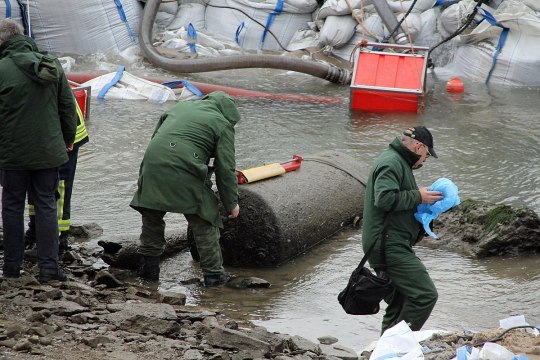
Did you know ... there is a special police unit in Germany that is called upon to safely dispose of bombs left over from World War 2, which still operates to this day.
In fact, 2000 tonnes of explosives are still discovered, on average, every year. As well as the unit needing to be called out for safety measures at least once a week.
An unexploded bomb was found in Berlin earlier this month, causing a mass evacuation and closure of the S-Bahn. With the same thing happening in Dresden back in April.
1 note
·
View note
Text

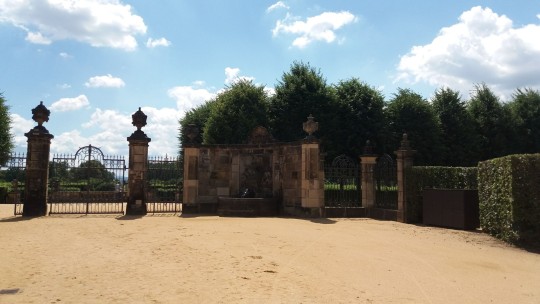
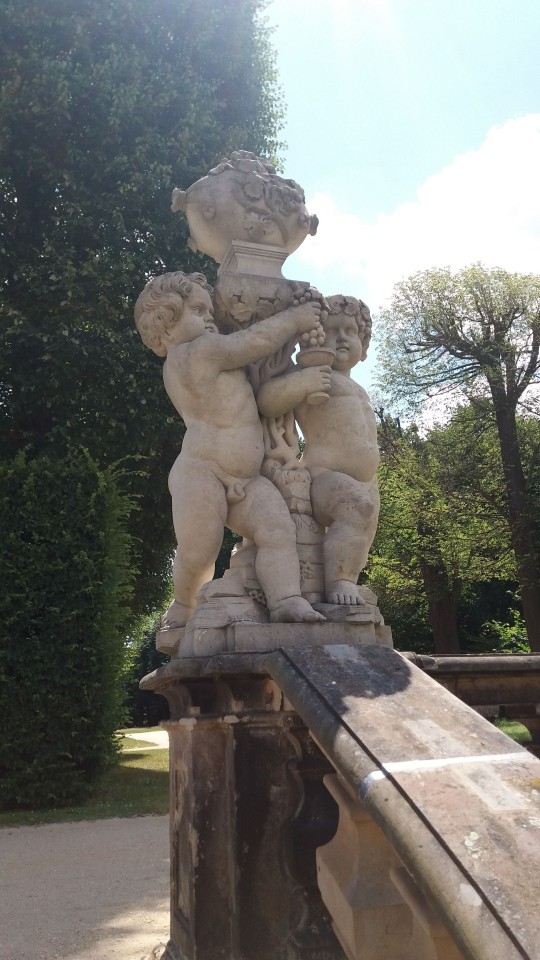
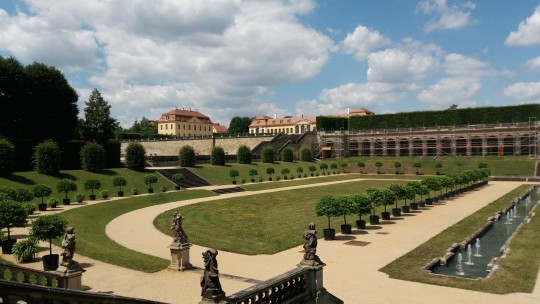
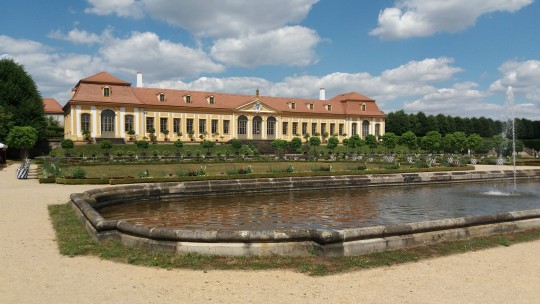
Reisen mit dem 9-Euro-Ticket
02.07.2022 -Schloß und Barockgarten Groß Sedlitz
Der Zug fährt pünktlich los und kommt pünktlich am Dresdener Hauptbahnhof an. Weiter geht es mit der S-Bahn. Die S-Bahn nach Meißen fährt heute nicht und meine fährt auch nicht bis nach Bad Schandau, aber in Meißen war ich schon und ich will ja auch nicht nach Bad Schandau. Bis nach Heidenau-Groß Sedlitz fährt sie und da will ich auch hin.
Auf dem Rückweg fahre ich wieder artig zum Hauptbahnhof und sichere mir so einen Sitzplatz.
Wenn man vom Bahnhof aus, die einzigen möglichen Weg nutzt, steht man plötzlich vor einer Fernverkehrsstraße. Überquert man die todesmutig, kommt man an ein Schild, dass zum Barockgarten weist. Man folgt einem murmelnden Bach durch den Wald, nach circa 20 Minuten steht man vorm Eingang.
Der Barockgarten ist wunderschön, der Weg hat sich gelohnt.
1 note
·
View note
Text

Hab dieses Ranking Ding jetzt auch gemacht
Danke an @torunarigha für die Idee 🌚
Ich hab die Starke Sympathie und Hass Kategorien weggelassen weil es mir oft zu schwer fiel zu differenzieren und so ist es ein wenig simpler
Vielleicht wird das hier ja ein Trend oder so lol
#die Sympathie Kategorie stammt größtenteils von family oder freunden#oder in freiburgs fall einfach die mannschaft und streich <3#antipathie teils obvious denke ich#ich hab so oft versucht mich mit union anzufreunden#jedes mal wurde ich enttäuscht#entweder vom verein der nicht aufhört zu sticheln oder fans die… nicht nett sind wenn sie merken dass man herthaner ist#ausnahme sind zwei ältere herren mit denen ich in der s-bahn vor jahren ein sehr angenehmes längeres gespräch hatte#da waren hertha und union noch in getrennten ligen und alle waren sehr respektvoll miteinander :)#mit dresden hab ich leider ähnliche erfahrungen gemacht#vllt gehe ich irgendwann näher auf die union geschichte ein idk#viele neutrale vereine rutschen bei mir mal hoch mal tiefer daher sind sie neutral lol#Bundesliga
5 notes
·
View notes
Text
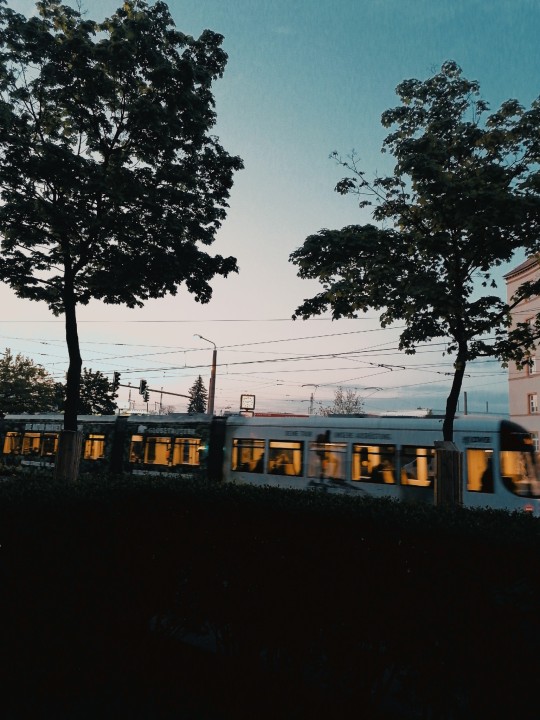
🌆🚋
1 note
·
View note
Text
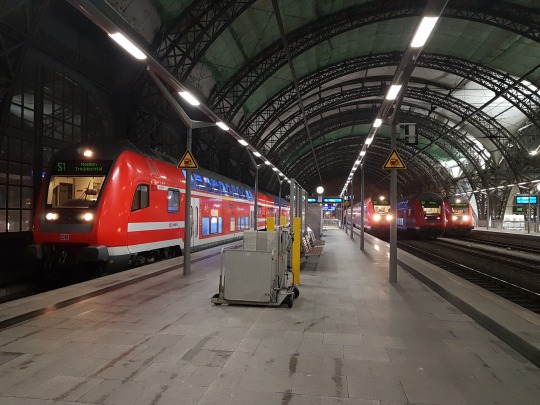
Moin. ...los geht's in alle Richtungen.
4 notes
·
View notes
Text
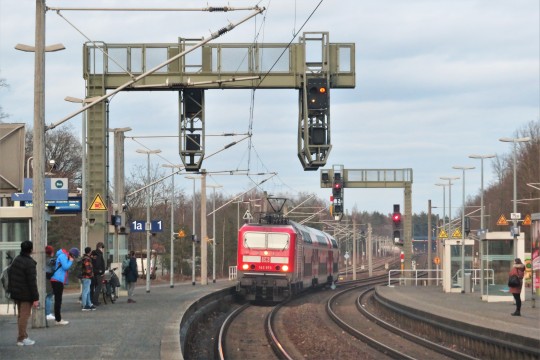
143 973 in Dresden-Klotzsche am 09.02.2024
#143 973#Br143#Br 143#S-Bahn Dresden#S-Bahn-Dresden#Dresden#S-Bahn#Sachsen#Dresden-Klotzsche#Klotzsche#Dresden Klotzsche#Dosto#Eisenbahn#Bahnhof#Bahn
0 notes
Photo
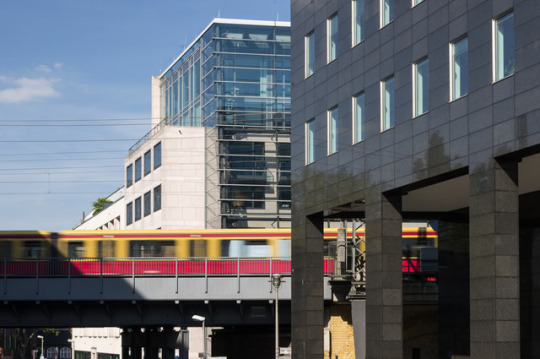
#berlin#germany#deutchland#train#sbahn#s-bahn#yellow#moving#blur#motion#postmodern#postmoderism#original content#photographers on tumblr#original photographers#erasmus in Dresden
2 notes
·
View notes
Text
History of Berlin’s railway system
Berlin is an interesting city to me. While some European capitals, like Paris or Vienna, clearly express a more or less well executed plan, and others like London just seem to sort of happened, Berlin has a history of grandiose plans that never get fully realised because funding runs out or the political situation changes drastically, until the next big plan comes along. This continues even to this day. A good example of that is the railroads of Berlin, a topic that I find interesting but that is never really described as a big picture thing anywhere.
The modern day scenario seems simple at first: There is a central railway station, and then a lot of minor ones. But if you look into it, you realise that this central station looks nothing like the historic terminal stations elsewhere, or that the center of the subway map is not the central station, but instead regional railway station Friedrichstraße. And the map is splattered with subway and S-Bahn stations like “Nordbahnhof”, “Anhalter Bahnhof”, “Görlitzer Bahnhof” and so on that are all named after some major station (“Bahnhof” in german), but the major station is nowhere to be found. So what gives?
Historically, Berlin’s railway situation started out very similar to that of e.g. Paris or London: Lots of different railway companies built their own lines into the city, each with their own major railway station. These stations were generally known after the cities or regions they served: Hamburger Bahnhof was the station for trains to Hamburg, same with Görlitzer Bahnhof, Dresdener Bahnhof and so on. The Anhalter Bahnhof served the historic region Anhalt, nowadays part of the state of Sachsen-Anhalt. The Stettiner Bahnhof (Stettin station) was renamed after World War 2 to Nordbahnhof (North station) because the town of Stettin had then become part of Poland as Szczecin; similarly the Schlesischer Bahnhof (Silesian station) was renamed to Ostbahnhof (East station) for the same reason. Finally the Lehrter Bahnhof served Hannover, but is named after the railway town of Lehrte just outside of Hannover because that’s where the line from Berlin met another pre-existing line. And just for clarity, the line leading to each station is named after the station, i.e. the line to the Lehrter Bahnhof is the Lehrter Bahn (Lehrte Line), the one to the Ostbahnhof (East Station) is the Ostbahn (East Line) and so on.
Unlike Paris or London, the independence of the different railway companies did not last long; the state of Prussia, of which Berlin was a part and arguably the center, bought all major lines during the second half of the 19th century. Later, in 1924, the federal Deutsche Reichsbahn took over from the Prussian state. While the lines did remain fairly independent, larger projects were now centrally planned, and as stations got upgraded, many got merged. For example, the Anhalter Bahnhof absorbed the duties of the Dresdener Bahnhof and became the prime station for any trains going south; meanwhile, the Lehrter Bahnhof swallowed the Hamburger Bahnhof, which remained as a freight-only station, and thus took over all trains going west.
All the terminal stations that weren’t connected were terribly inconvenient, of course. Passengers could walk between them or take a carriage ride (not that they’d be happy about it), but for freight this wasn’t as easy. The first attempt to solve this was the Verbindungsbahn, “connection line”, which connected several stations at street level, essentially as a tram, but running main line locomotives and cars. Since those have much weaker brakes than trams, this mean that speeds were slow, but accidents were also still frequent. The whole thing was a nuisance and shut down relatively quickly.
The second attempt was much larger: The “Ringbahn”, the circle line, connected all the stations as a big circle. It was meant primarily for freight, so it did not pass near the station buildings, but rather several kilometres away from them. That way trains could access the ends of the associated freight yards. While it was meant for freight, suburban trains were also offered and proved very popular. They still run today, as lines S41 (clockwise) and S42 (counter-clockwise). You can stay on these trains basically indefinitely as they orbit Berlin at exactly one round per hour.
The Ringbahn, in short the Ring among friends, was a roaring success, for freight. For long-distance passengers, it was kind of useless. That’s where the second line comes in, the Stadtbahn, which roughly translates to City Line.
(A note about terminology here: Stadtbahn is also the German term used for what is called light rail in English, i.e. tram systems that are a bit subway-like. Thankfully Berlin doesn’t have that, just a normal subway and a normal tram. Also note that Berlin’s suburban railway system is called S-Bahn; nobody knows whether it derives from Stadtbahn or not, but the S-Bahn covers more than just the Stadtbahn and the Stadtbahn carries trains that are not S-Bahn. Sorry for the confusion, I didn’t invent these terms.)
The Stadtbahn connected many major stations on a west-east line. It technically starts in Spandau and ends at Ostbahnhof (where it becomes the Ostbahn), but for practical points and purposes it’s best to think of it as a line that runs more or less straight through the Ring in east-west direction. The parts where it crosses the Ring are creatively called Westkreuz (West Cross) and Ostkreuz (East Cross), respectively. The Stadtbahn carried both suburban trains and some long-distance trains, though most still ended in their respective terminal stations. Thus, the problem was solved for east-west lines; people could take a through train or use the suburban trains to quickly transfer between stations. However, the line did not connect the Nordbahnhof (North station) and the very important Anhalter Bahnhof (for trains going south).
This problem got solved in the 1920s by constructing the Nord-Süd-Tunnel (North-South-Tunnel). This one only carries the suburban trains, which had by now been electrified and renamed to S-Bahn, to better compete with the U-Bahn, the subway network. Since the S-Bahn uses subway-like technology, the Nord-Süd-Tunnel seems very much like a subway line when you’re in it. The differences are mostly about who is responsible (the government-owned railway company instead of the city subway company) and service patterns (S-Bahn trains run not quite as often, but far wider out into the suburbs).
The Nord-Süd-Tunnel primarily connected the Nordbahnhof and Anhalter Bahnhof, but also ran further north and south than either. Thus it created a new line that bisected the Ring in North-South direction. The stations where this line crosses the Ring are nowadays Südkreuz (South cross) and, you guessed it… Gesundbrunnen. Yeah, they tried renaming it to Nordkreuz (North cross), but the locals preferred the old name. The Nord-Süd-Tunnel and the Stadtbahn cross at the station Friedrichstraße; as far as I know there have never been any plans to rename it to “central cross” even though it would make sense.
So at the end of the 1920s, we have terminal stations, we have a Ring that used to be outside of the city but is very much becoming inside it as the city grows, and we have an east-west and a north-south connection between the terminal stations, where the east-west one can also be used for through trains. North-South not so much, but because there is nothing interesting between Berlin and the Baltic sea in North direction, there isn’t really that much demand for it anyway. (Dear readers from Rostock: You know I’m right.)
The main problem now is that the Ring is getting a bit too crowded with all the freight trains, not all of which want to go to Berlin anyway. Construction starts on a new line, the Güteraußenring (Outer Freight Ring), to form at least a partial outer circle for freight trains that want to avoid the busy fiddly bits of inner Berlin.
And then Germany goes ahead and starts a war.
German railways are a crucial part of the worst war in human history, handling essentially all the logistics for it. People talk a lot about the Autobahn motorway network that Hitler took credit for, but the war logistics were all about railways. That includes the Holocaust, in which people were carried to the death camps by train.
When the war was over, bombing and the fighting had reduced much of Berlin to rubble. Most of the railway network was damaged, although a lot was brought back rather quickly. The fundamental design of Berlin’s network was still the pre-war state, with all the same stations and lines, although now lacking roofs on the stations and with much lower capacity. The railways still remained more important than ever, especially for all the displaced persons seeking new homes.
At the same time, the Allieds divided Germany into four sectors, which soon evolved into what we colloquially know as West Germany (American, British and French sectors) and East Germany (Soviet sector). Berlin was fully surrounded by the soviet sector, but got a special status where it was split into (the same) four sectors as well. That later devolved into the division of a western part of Berlin and an eastern part of Berlin, as the Cold War began in earnest.
(Aside: Especially in Germany, the Cold War was in part full of pettiness on either side, and there was a time when it was a political statement whether you said Westberlin or Berlin (West). Let’s not get into this, the post is way too long as it is already; nowadays you’re free to use whatever you like.)
One of the last things all four Allied powers could agree on before the cold war started in earnest was that the railroad of the Soviet sector should operate the railroads in all of Berlin, presumably mostly for practical purposes since it was not possible to reach Berlin except by passing through the Soviet sector anyway. (Well, except by plane, which is another important part of Berlin’s post-war history that I can’t go into here right now)
The division of Berlin happened along the lines of pre-existing local administrative boundaries. Of course, commute routes and all sorts of infrastructure had habitually crossed these lines before, so the division soon began to hurt severely. That was kind of the point; Berlin had been split into sectors precisely because the Allieds did not want a functional powerful Germany and german government any time soon again.
For the railroads, the split was particularly problematic. Almost all major stations lay either entirely or partially in the western sector, or the lines to it ran through the western sector. The one exception was the Ostbahnhof (East station), which lies entirely within the Soviet sector.
This was a problem for the newly created GDR (East German) government, which sought to control and stop traffic over the new inner-german border. As a result, all the big terminal stations got closed down in the early 1950s, except for the Ostbahnhof, which essentially became East Berlin’s single main station. For now, the Stadtbahn, Nord-Süd-Tunnel and Ringbahn still existed and ran basically like before. They all crossed sector boundaries, but they were indispensable for traffic to and from East Berlin; there was just no way around them.
So the next step was to build a way around them. The Außenring (Outer Circle) was built between 1951 and 1961, using parts of the Güteraußenring (Freight Outer Circle) that had been started before the war, but replanned so it clearly avoided any western territory. All lines leading into Berlin got massive junctions where they met this new outer circle, which allowed diverting the trains to the Outer Circle instead. Some also allowed diverting trains from the Outer Circle to West Berlin, but most didn’t. For a good example, look at Hohen Neuendorf, a suburb just outside of Berlin (and thus fully in the soviet sector), which contains a massive loop arrangement that allows trains from the North (via the Nordbahn) to continue in either direction along the circle, but does not allow trains on the circle to continue south into (West) Berlin. The single track that leads south nowadays, for the S-Bahn, was actually cut and only restored in the 1990s.
With this project finished, the GDR government did not depend on West Berlin for rail travel anymore, so the very same year, they started building the Berlin Wall. The division between the East and West was complete and seemed final.
Railway lines into West Berlin still existed, though. The Nord-Süd-Tunnel, which crossed the sector border dozens of times, became limited to people from West Berlin only; station exits in East Berlin were closed, and stations that only had exits in East Berlin were closed entirely, with armed guards on the platforms that the trains were only allowed to pass at slow speeds. The (inner) Ring remained for suburban trains that could only run half of it now on either side, and for some freight. Some of the lines to the old terminal stations also remained as freight lines. The Hamburger Bahnhof, for example, became a container freight terminal in the 1980s. Finally, the Stadtbahn became the main line connecting West Berlin to West Germany via rail. Its central station became the previously unremarkable Zoologischer Garten, or Zoo in short, the largest regional station along the line. The “international” trains that officially connected East Germany with West Germany started and ended in Friedrichstraße, the first station of the Stadtbahn that was entirely in the East, which gained massive border control facilities.
And that was basically it for four decades. Railways in the West of Berlin slowly atrophied; since the railways were operated by the East and all ticket money went there, every Berliner saw it as their patriotic duty to avoid it where possible and instead take the subway, and for longer distances, prefer travel by coach or flying, made dirt cheap thanks to West German subsidies.
In the East, the railways remained dominant and important, but lack of money meant very little was actually being built. The outer circle became an important line for suburban trains, which became known as “Sputniks” - just like the satellite, they orbited West Berlin. The main station was the Ostbahnhof, which even got the name “Hauptbahnhof” in the 1980s but then lost it again in the 1990s. Through trains often instead stopped in the local station Berlin Lichtenberg, which lies on a line connecting the inner to the outer circle and thus allowed trains from all direction to all directions.
And then, to everybody’s surprise, the Wall fell.
The first few years after the Wall fell were mostly hectic attempts to get any meaningful service up and running again, and closing the gaps that the wall had made. The Stadtbahn, Nord-Süd-Tunnel and finally the Ring all got reconnected one by one. Long-distance trains mainly used the Stadtbahn, stopping in Zoo for the West and Ostbahnhof for the East. But both were small, and trains to North or South needed to take huge detours via the Außenring. With Berlin set to grow massively in a reunified Germany, it was time to go big or go home, and to completely rethink how the Berlin’s railway system, which had been gutted forty years prior, worked.
Thus was born the Hauptbahnhof, a term that gets translated to English as either central station, main station or not at all, depending on how the translator is feeling on any given day.
This new central, most important station of Berlin was a massive undertaking. The station sits on the space of the former Lehrter Bahnhof. This space right in the middle of the reunified Berlin was essentially empty, occupied only by abandoned railway tracks on the West side, and the Wall and its associated Death Strip on the East side. The station is located right on the Stadtbahn, offering it great East-West connectivity. For North-South connectivity, they couldn’t use the existing Nord-Süd-Tunnel, which was too small for regular trains, so they built a second North-South route with its own tunnel, specifically for long-distance trains. These tracks intersect with the Stadtbahn at the Hauptbahnhof, where they form the lower level of the station. The new north-south-tracks cross the Ring at the same locations, Gesundbrunnen und Südkreuz. Specifically around Gesundbrunnen there are major track works (which extend all the way to the next stations in all directions) that also allow trains in East-West-Directions to be routed onto the lower North-South tracks, which allows keeping the Stadtbahn free, as there is much more East-West than North-South traffic.
And that’s basically where we’re at right now: One central station for both east-west and north-south traffic, with two circles to funnel trains from all directions to whatever tracks you prefer, and an extensive suburban rail network.
But of course Berlin is never finished. Some of the pain points that people are trying to address right now:
First, the central station could be built because it is in the middle of nowhere, but the problem is that now it is in the middle of nowhere; a station that can essentially only be reached by rail. Since it was built at a new North-South-Tunnel, you can’t access the old North-South-Tunnel from here, so for the first few years almost everyone who arrived here looked around, then immediately boarded a suburban train to go one station further, to Friedrichstraße, because that was the station from which you could actually get to places.
It’s gotten somewhat better due to more development around the station, and due to a tram line opening there. The history of the subway line U55 is again too long for this already massive post, but basically the central station will finally get a useful subway connection by the end of this year (2020).
The next big plan is to build essentially a third North-South-Tunnel for the S-Bahn suburban trains, which will first run from the Ring to the central station, then back to the old Nord-Süd-Tunnel for a bit, before then continuing west along the Tiergartentunnel again. The project is known as S21 - no relation to the one in Stuttgart, except for the fact that it’s also massively behind schedule, over budget, and nobody knows whether it’ll ever be finished.
Another problem is that several of the radial lines into Berlin got cut behind the Außenring. A good example is the Dresdener Bahn from Dresden: It runs normally from Dresden to the Außenring, but there, it ends. The line does continue, but at the moment only for S-Bahn trains, so long-distance trains need to continue along the Außenring until they reach the Anhalter Bahn, which allows them to continue into the city. A similar example exists at the North end with the Nordbahn (around Hohen Neuendorf which I mentioned before). These will need to be restored at some point; the Dresdener Bahn in particular because it will also be the main rail access to Berlin’s new airport, which is another fun story in and of itself.
Beyond that, no major changes seem on the horizon right now. There are more plans, but they all focus on mkaing things better for regional trains, reopening S-Bahn lines, new regional stations at existing junctions, and more subway and tram lines. But the major spine of the network looks like it has finally reached a steady state that is a good foundation for all future work.
Of course, this is Berlin, so who knows how things will look in a couple of decades.
#berlin#railway#railroad#history#germany#sbahn#i read a post saying please write long posts explaining your particular fields of interest#next thing i knew i had written 4000 words#i know this will get no notes but i had fun writing it and sometimes that's enough
2 notes
·
View notes
Text
Last spring in Finland I attended a course “German for those who are going to have an exchange year”. They told us about the stages which one usually goes through during an exchange. As far as I remember, the stages were roughly somewhat like this: firstly one views everything and everyone better than in their home country and everything is super interesting and fun. This basically means that the everyday life hasn’t kicked in yet. The next one is getting annoyed at everything and everybody. Comparing the country to your home country and maybe even feeling like it would have been a better idea to just stay home. After this comes the stage of adaptation where one gets used to customs and stops comparing everything to one’s home country. Last phase is coming back to home country and seeing it in a new way. And of course telling stories of the exchange year to friends and family until they are bored to death.
I remember thinking two things when we were taught about this. Firstly, who the hell would go through a phase of hating the country they go to? It seemed so irrational. The second thing was “Now that I’ve heard about this stuff, I can rise above it and use my brain and self-knowledge to avoid it. Yeah... As you might guess, it did not happen. I admit, during last few weeks I have spend a huge amount of my time wallowing in “WHY DO YOU DO THIS LIKE THIS” “Why can’t you do it in the right way” “What the hell is wrong with Germans!”. Mostly my frustrations have been related to my university. The mornings I am usually in a good mood. I drink my coffee, get ready (I have started to care more about what I wear and how I look like now that I am in Berlin hahaha) and go to school. All in all it takes me around 45 minutes to get from my home to university which includes walking, tram and S-Bahn. The way there and back are usually my favorite bits of the day. I enjoy watching people, traveling through Berlin in S-Bahn and listening to music. On the way back from university the people in public transport are usually going to pubs or parties so it’s nice to see happy and lively faces. I try not to overwhelm myself with school even though I feel like I need to be constantly studying to keep up. The thing is, even though the courses seem a bit challenging, partly because I am not used to academic English and partly because I am studying in a new study field, I find all of them interesting and genuinely think they are useful. I think I will shortly find a balance because now I feel super drained after every day and still feel like I have the “responsibility” to do fun things and go to places whenever I am not studying. It’s like a freshman year all over again.

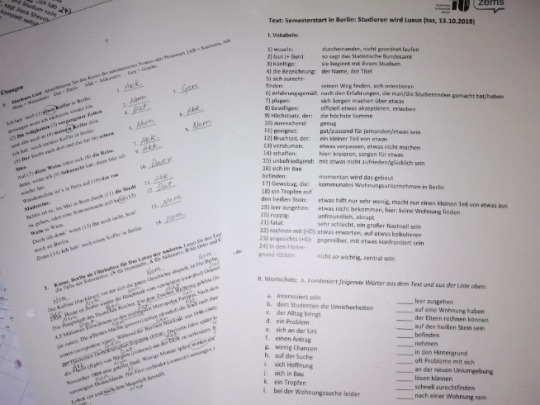
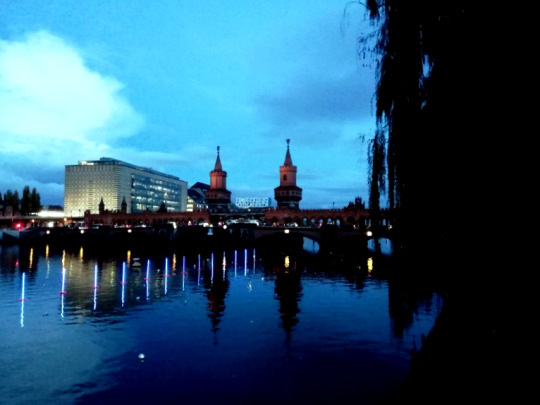
So, what has happened after the last post? Quite a lot. I was on a Wanderlust trip to Dresden in October. We also visited a famous bridge (Bastei) in Saxony. The views and the scenery were incredible! Dresden was also very cozy and historical city. It was a lot smaller than I expected. We only had a few hours to browse through the city but we could easily reach the most important sights by just walking. On the bus we opened bottles of wines we got from Lidl and played some car games with the people who sat around me. I suggested searching “questions to get to know each other” so on the few hour way back we just simply shared our biggest secrets and fears as if we had been knowing for a long time. The french boy sitting in front of me got interested as I mentioned we are throwing a sitting here, so he wanted to help. We formed a committee of 5 people for a sittning, planned it in a cafe and contacted international office. Their response was rather dry and due to International office organizing a similar event in December, we decided to postpone the sittning and start planning it again in January.
Wanderlust trip was good because everything was already planned and sorted out for us. We just had to be on time to catch the bus. I already booked another wanderlust trip to Magdeburg in December. They have a Christmas market there. I also want to see the city that was my other option to have an exchange year in. By the way, I am super glad I ended up choosing Berlin over Magdeburg.
The next day me, the Austrian girl who sat next to me on the bus and her friend went to see a light show in the city centre. There is this light festival held in Berlin where they project things onto famous buildings and monuments. The one projected on Brandenburg gate left me speechless. They projected things like collapsing of the wall, JFK’s speech and techno culture of today’s Berlin.
One Friday evening my friend, my roommate and her friends decided to go to a burlesque show. The bar was super fancy as was the show. I just couldn’t get my eyes of the woman who performed. She danced to a remix of Britney Spears’ Toxic so naturally I had to ask her after the show if she liked Britney Spears. She said they only picked it because they needed something that people would recognize but at the same time something that isn’t the actual song. :( She was amazing tho.
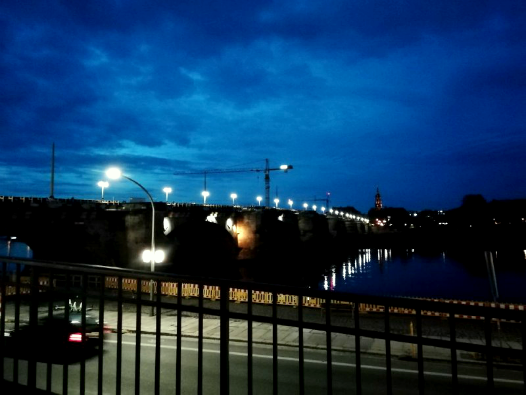
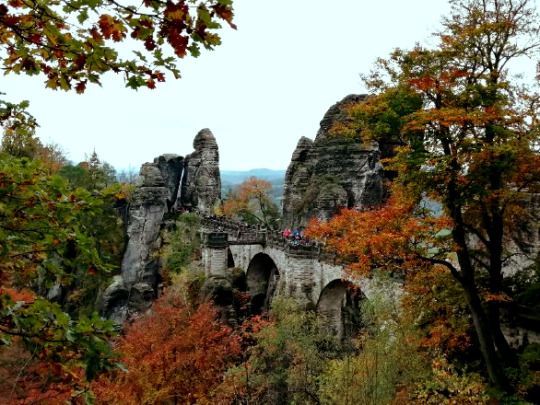

In October I also went to see Prinz Pi live at Columbiahalle. I’ve never been to this venue before and it was so cozy! Man the concert just got better and better and I just had goosebumps for like half of the show. At the encore Prinz Pi said something in the lines of “You know.. The next place I go to.. You don’t want me to tell the audience that the audience of Berlin was dull? Go crazy then!” and I have never seen an audience getting so hyped during a song (”Gib dem Affen Zucker”). I got inspired of this so I already booked a ticket for Sido’s Christmas show in Columbiahalle. Actually I tried to go to his normal tour’s concert which is actually today, but I thought too long and it got sold out. People were asking 200€ per ticket (the original was around 45€) so I gave up. Then I decided to go to his christmas show but AGAIN thought too long because they are held in 20.-22.12. and I needed to sort out my flights to Finland first. But one day I decided to go to eventim’s page to see if someone was selling their ticket (they were, but overprized again) and I saw that there was one original ticket on sale even though it was sold out before. Someone had cancelled their ticket and some forces of the universe told me to refresh that page at a right moment. So now I have my ticket and just can not wait for it!


In the beginning of November I went to Prague to see my friend. The train ride was only 19 euros and I could easily do my homework and watch Kotikatu there. Priorities were sorted out! I navigated to Revnice where we went to a local brewery and shared things about our lives. The beer was the best beer I have ever had in my life which is sad because I literally can’t get it anywhere else than from there. Damn brewery! The next day we played board games, ate well and went swimming. My friend introduced me to a new thing: putting honey in a coffee. At first I doomed the though: ew, who the hell does that? Honey belongs to tea, not coffee. Then I tasted it and... it was delicious. It is yet to discover if it because of the honey or their super fancy coffee maker. Then we went to the brewery again and played a Czech card game called “bang”. I think I got the gist of it and even won the game once. On our last day we were just sightseeing and went to a concert together. The songs were translated to me and for a moment I felt super ambitious to learn Czech. I don’t want to miss out on funny songs just because I don’t know the language!
Last weekend there was a celebration in Berlin due to it being 30 years from the fall of Berlin wall. It was a bit similar to the light festival. We were out with friends two nights in a row and found a super cute place in Prenzlauer berg: Houdini. They have Indian food and cheap cocktails. We continued the evening to this living room looking place that was connected to a Späti. The Späti-drinking culture is something that is missing from Finland. Here Spätis are these small shops that mostly sell drinks (beer, soda, water, cider and so on) and candy.They are open late which is actually where the name Späti (Spätkauf = late shopping) comes from. There are often benches and tables where people can enjoy their drinks which are cheaper than in normal pubs of course. The Späti man asks if the beer is to be enjoyed in the living room and adds a small fee if it is. And there’s a bottle opener on the counter. Everything is sorted out so in my opinion Späti-drinking is a good way to go out and get drunk with small budget.
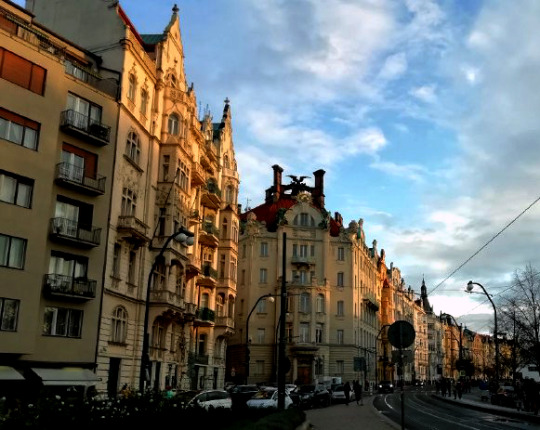
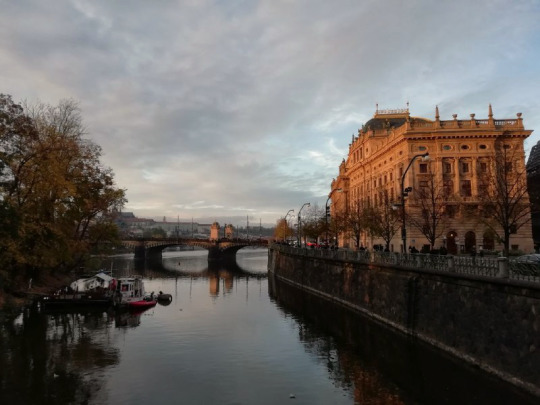
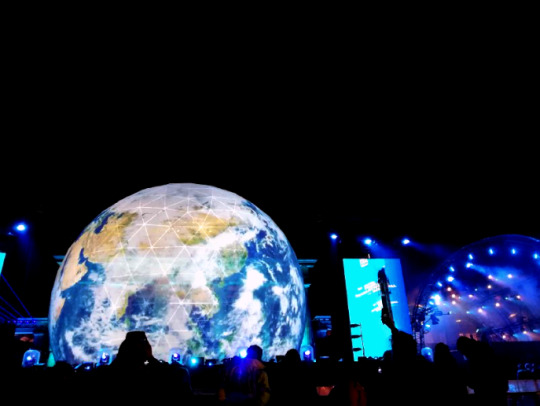

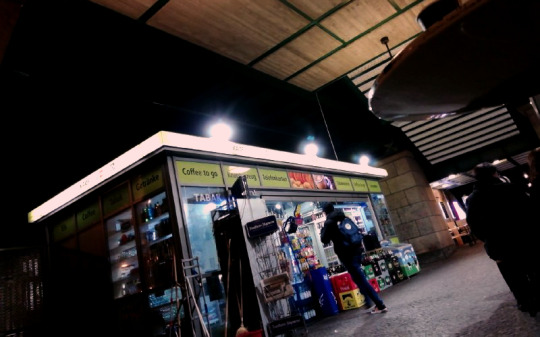
Yesterday we had an excursion with my German class. We went to Berlinische Galerie which is a museum of contemporary art. They had an exhibition of Bauhaus, the art/design/architecture Academy in pre-WWII Germany that affected modern design and architecture. We were walking around and filling up a worksheet the teacher gave us. I enjoyed it so much and everything seemed so pleasing to the eye.
Afterwards we went to a open stage event which was basically a talent show. There were 10 acts of which everyone had 10 minutes to convince the audience who voted for a winner. We also had beer and wine counter there naturally. My favorite was this one dude in tight ballet outfit who preformed a circus act which was funny and impressive at he same time. His background music was swan lake but the dude sang along in a terrible way which made it less serious. Then he juggled with 6 balls and every time he messed up, he cried out in a dramatic way. Then at the end of the show he turned his back to the audience and we could see he was digging something from his crotch and then he turned around and swiped of sweat from his face with a pile of tissues he had as a crotch-filler the whole time. The tipsy audience laughed so much that the winner was pretty much clear at that point. The dude who went after him performed a horrible keyboard improvisation and his face screamed “ I am sorry to be here, I just want to flee!” hahahahah. The act that came second was funny as well, they performed “Let it go” but with a German translation, the google translate type of translation. Conclusion is: the audience wants to laugh at talent shows, not see real talent.
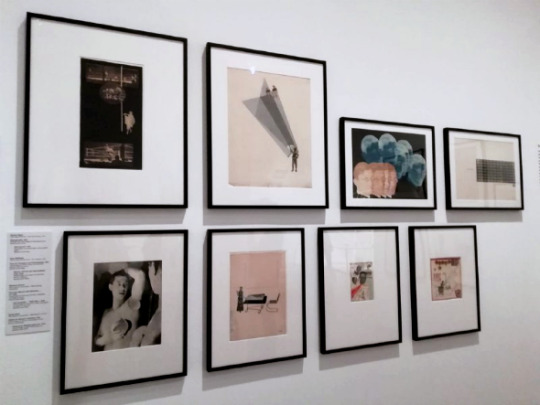
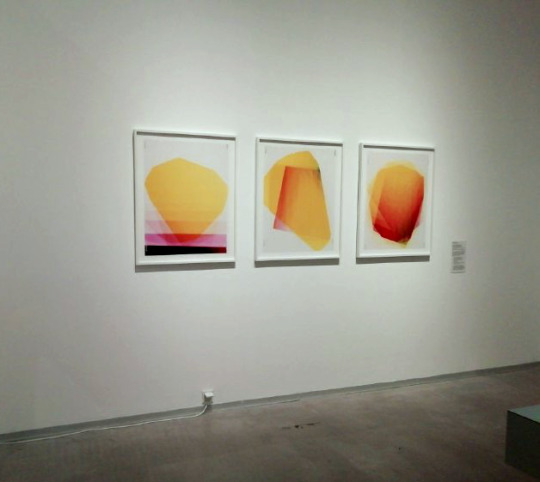
On top of all the events I have also been attending the hiphop dance class I think I told about. The teacher is super funny (and hot :D) and the dancing is so intensive and so much fun! I look terrible, though but it’s not the main point here. I might continue this hobby when I get back to Finland.
Now I have to start packing my things because I am going to Szczechin (Poland). I heard it is a city where Berliners go to shop because it is cheaper there. I feel like this trip can be either a massive success or a terrible flop. Time shows...
1 note
·
View note
Text
12. September | 88. Typostammtisch
The Stammtisch in September takes place a little earlier than usual, but there are special guests. Heike Schnotale and Max Lotze of the venerable Offizin Haag-Drugulin from Dresden are coming. The topic of their lecture is "Between old treasures and fresh casting - lead typesetting as an everyday experience".
The location is Cafe Hardenberg in Berlin Charlottenburg.
More info typostammtisch.berlin!
time: 19.00 h
Café Hardenberg
Hardenbergstraße 10
10623 Berlin
U-Bahn: U2 to Ernst-Reuter-Platz or U9 to S+U Zoologischer Garten
S-Bahn: S3, S5, S7 oder S9 to S+U Zoologischer Garten
Bus: M45 or 245 to Steinplatz
2 notes
·
View notes